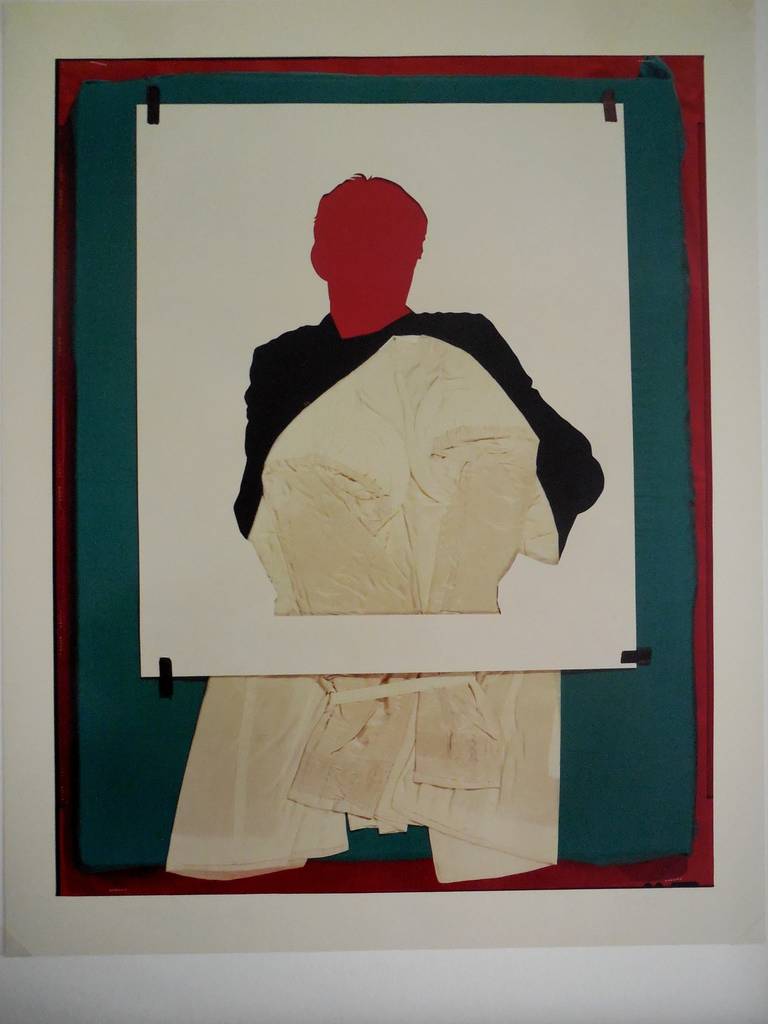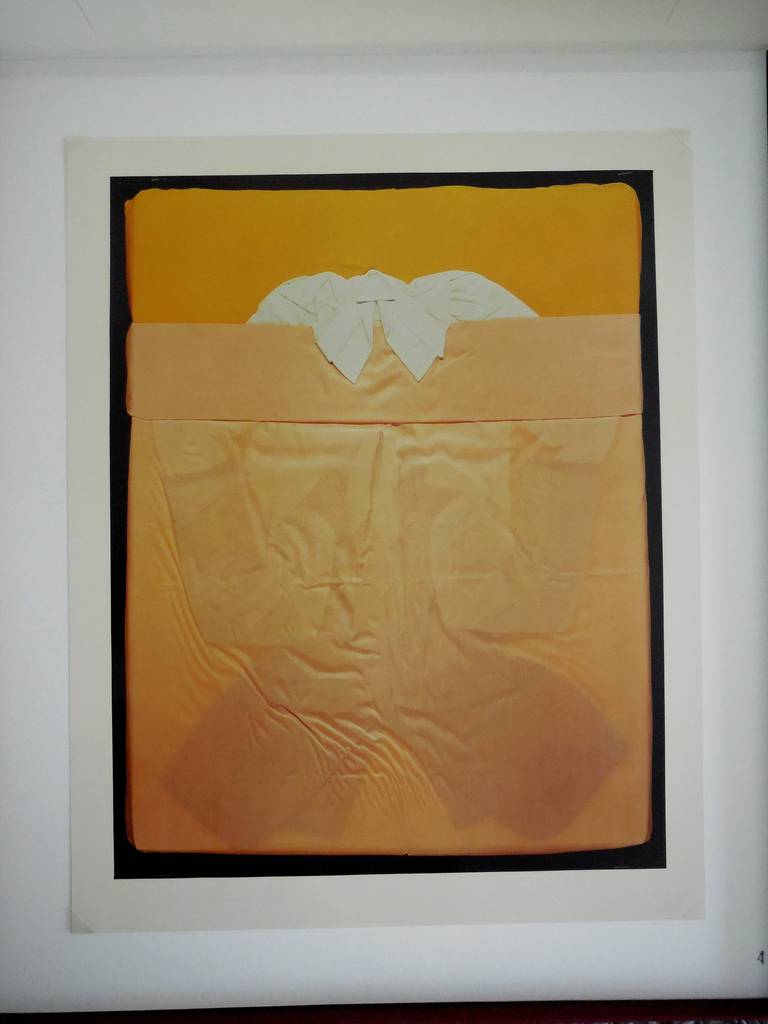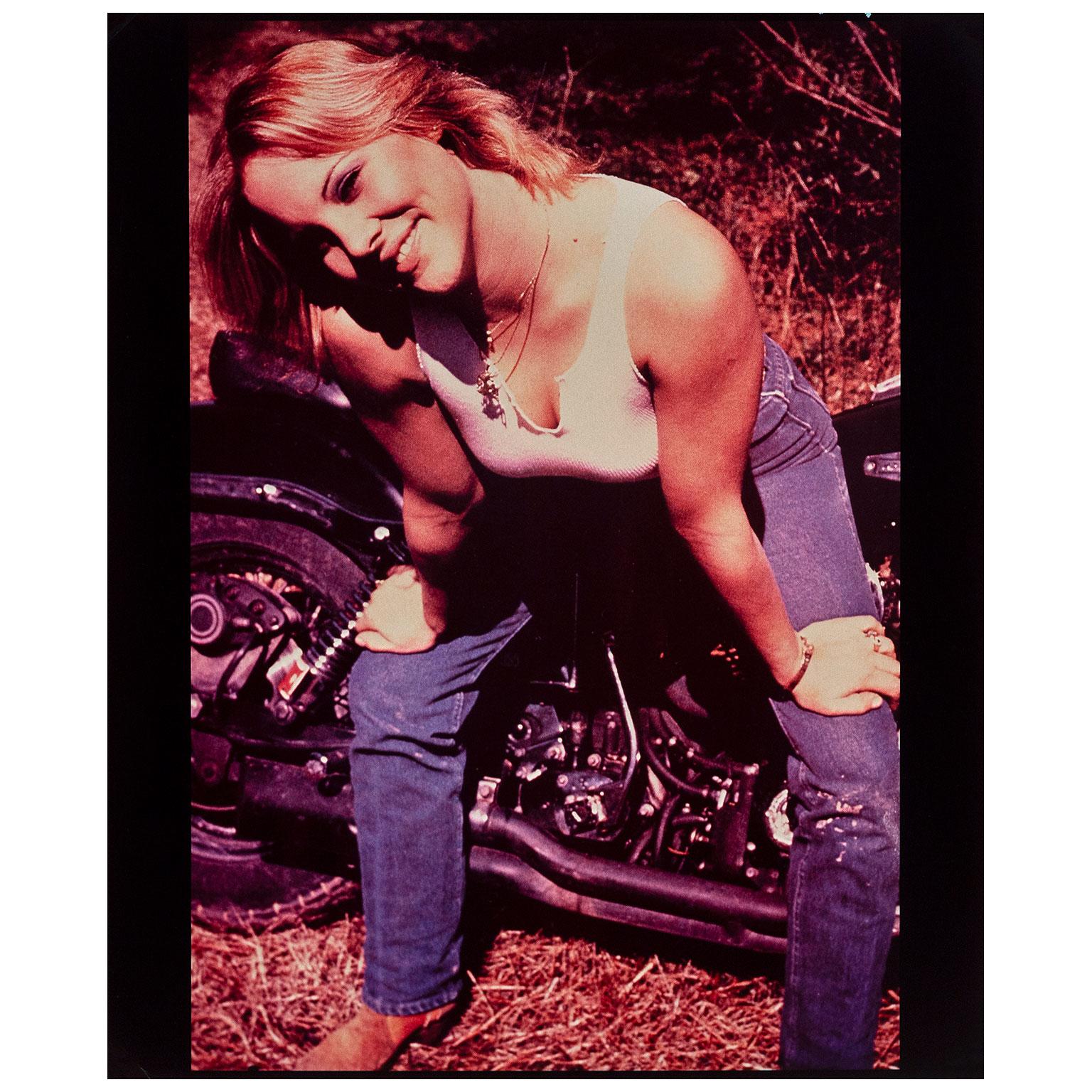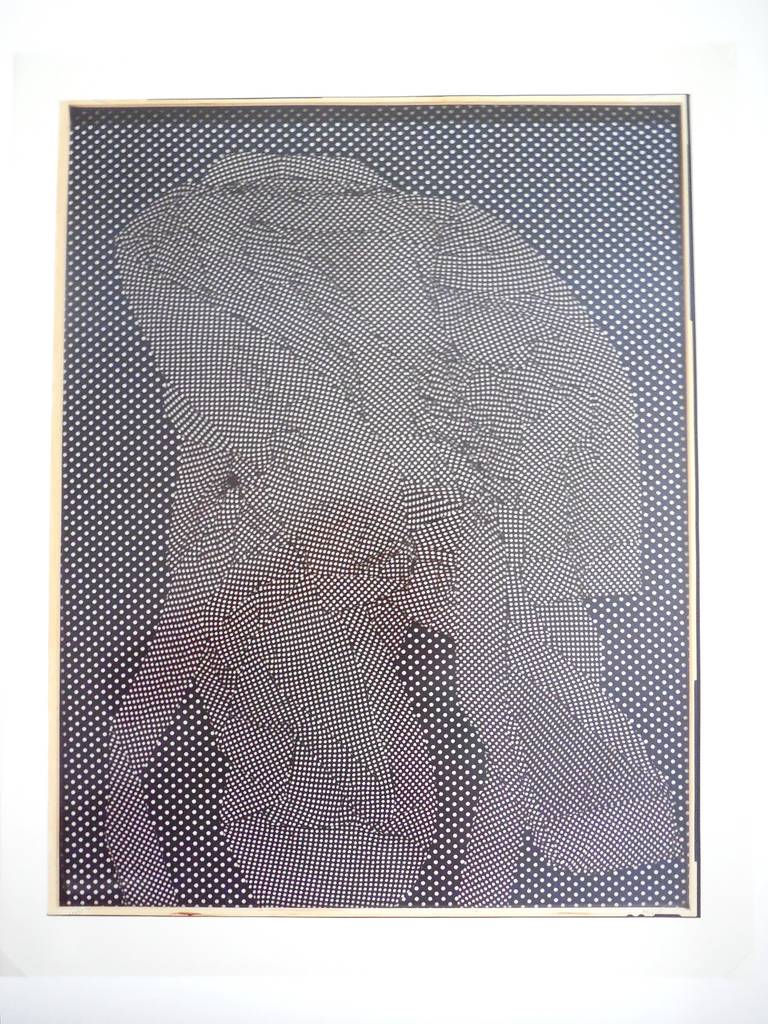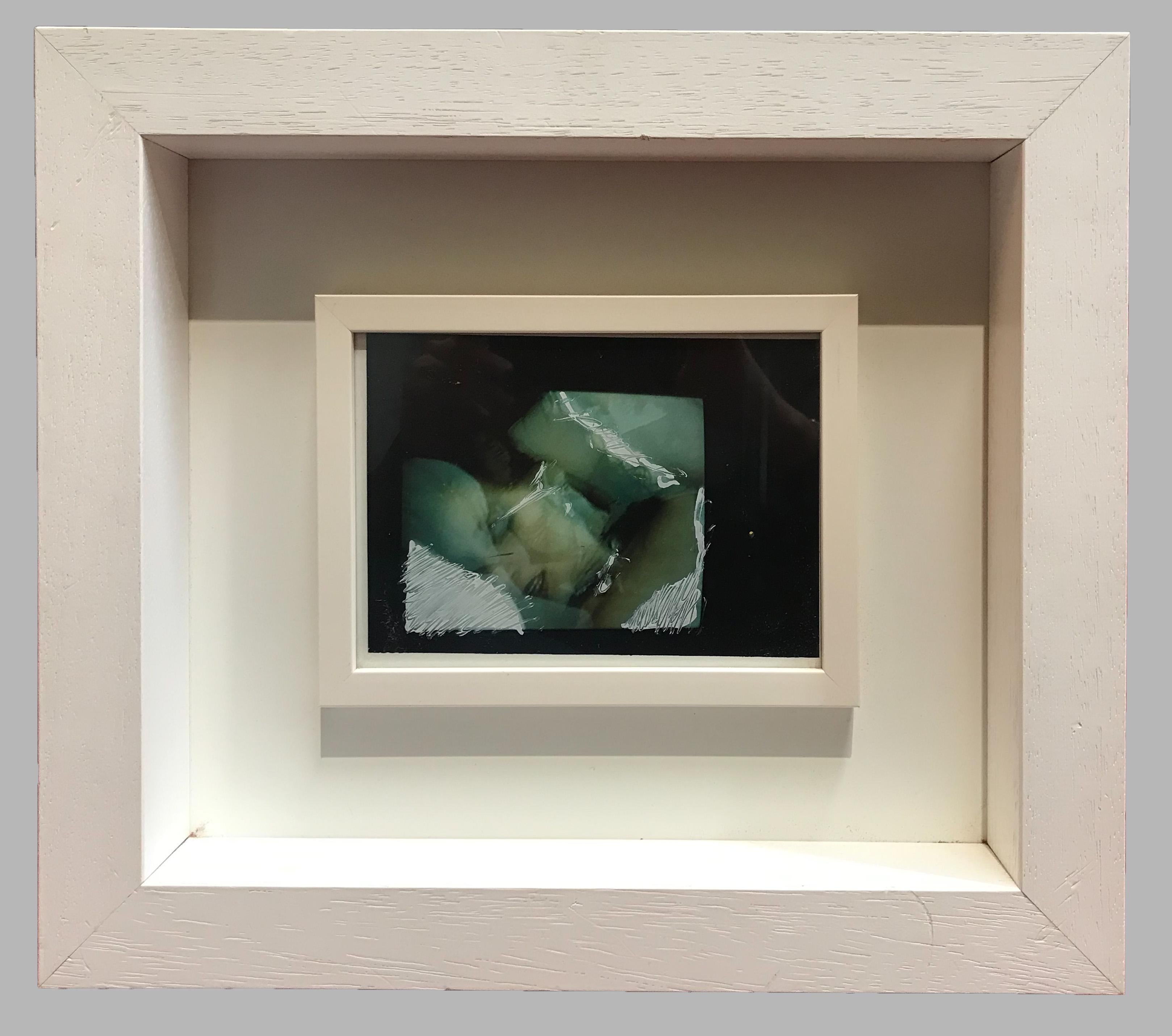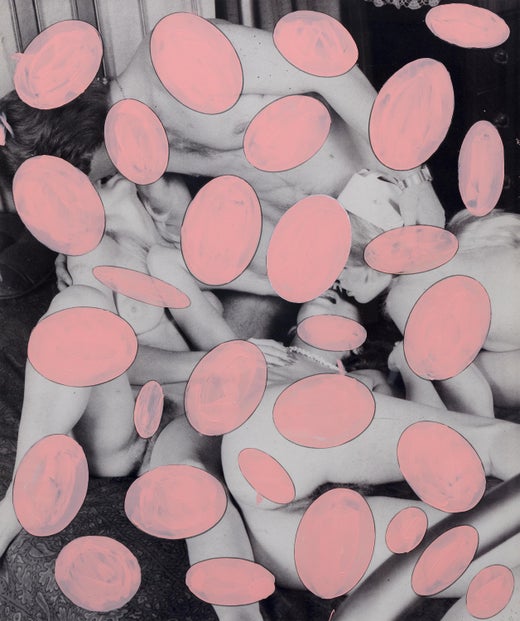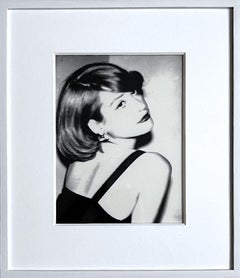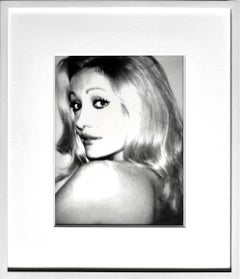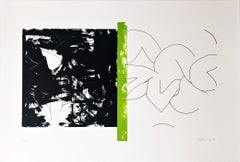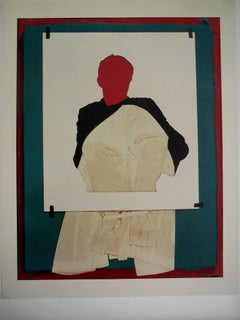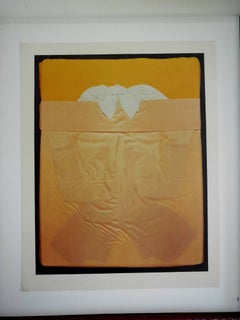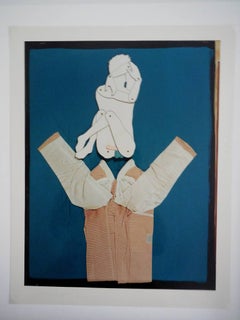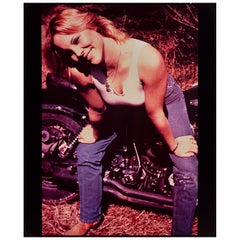Items Similar to Angie Dickinson, hand Signed/N, Barbara Gladsone, Sothebys & Estate of Vera List
Want more images or videos?
Request additional images or videos from the seller
1 of 11
Richard PrinceAngie Dickinson, hand Signed/N, Barbara Gladsone, Sothebys & Estate of Vera List1986
1986
$75,000
£56,949.28
€65,125.75
CA$104,785.88
A$116,544.77
CHF 60,856.06
MX$1,418,225.85
NOK 777,224.70
SEK 728,899.65
DKK 486,058.43
Shipping
Retrieving quote...The 1stDibs Promise:
Authenticity Guarantee,
Money-Back Guarantee,
24-Hour Cancellation
About the Item
Richard Prince
Angie Dickinson (Angie from Untitled Portfolio) from the estate of Vera G. List, 1986
Large Color Polaroid (w/Barbara Gladstone & Sotheby's Gallery Labels)
Signed and numbered 5/5 on front.
Bears Barbara Gladstone Gallery label
Bears Sotheby's stickers on the back of the frame
Frame included: elegantly framed in a museum quality white wood frame with UV plexiglass
This work has impressive provenance as it was acquired from a sale of the Estate of Vera G. List, the art collector and philanthropist and founder of the legendary Vera G. List print program at Lincoln Center. It bears the original Barbara Gladstone Gallery label on the verso of the frame, as well as the Sotheby's sale stickers from 2001. Richard Prince’s Untitled (Angie Dickinson) belongs to a series of pictures created in the mid-1980s in which the artist appropriated images from erotic movies, subsequently adding text based elements. Gleaned from Brian De Palma’s Dress to Kill (1980), the image in Angie Dickinson refers to the brutal murder of the actress – slashed in an elevator – as elucidated by the printed text above (‘Angie Dickinson pays for her sins in Dress to Kill’). Prince’s attention in Misty Regan is transferred to the actress’s expression of sexual excitement in a close-up from one of Regan’s erotic scenes from the eighties. It was during this decade that the artist focused on cinema as a ready-made source for his art and a subject for his writings. In this regard, in 1985 Prince wrote Anyone Who is Anyone, a short fictional story in which the main character is obsessed with cinema: ‘For one year he rented movies – VCR videos - and watched them on a twenty-five-inch colour Sony monitor at her apartment. He watched the movies alone, late at night after she had gone to bed. He watched two-hundred-and-seventy-five movies that year’ (R. Prince, ‘Anyone Who Is Anyone’, reproduced in R. Brooks, J. Rian and L. Sante, Richard Prince, London 2003, p. 122).
This work is matted and framed and in excellent condition. In original hand made wood frame with Barbara Gladstone Gallery label on the back, as well as original Sotheby's stickers.
Dimensions:
Framed: 30.5 x 24.5 x 1 inches
Sheet: 30 x 22 inches
PROVENANCE:
Estate of Vera List, New York
Barbara Gladstone Gallery, New York
Sotheby's Inc., New York:
Thursday, November 15, 2001 [Lot 00299]
Contemporary Art: Part Two (Afternoon)
- Creator:Richard Prince (1949, American)
- Creation Year:1986
- Dimensions:Height: 30.5 in (77.47 cm)Width: 24.5 in (62.23 cm)Depth: 1 in (2.54 cm)
- Medium:Permanent Marker,Polaroid
- Movement & Style:
- Period:
- Condition:
- Gallery Location:New York, NY
- Reference Number:1stDibs: LU1745215783582
Richard Prince
Richard Prince (American, b.1949) is a painter and photographer, best known as a pioneer of Appropriation Art. Born in the Panama Canal Zone, Prince grew up in Massachusetts and moved to New York in 1977, where he prepared magazine clippings for Time-Life, spurring his interest in advertising and consumer imagery. He began creating works based on various pop culture images taken from magazines and newspapers, often re-photographing and manipulating the images in his own works. Considered by many the father of Appropriation Art, the majority of his works includes scandalous subject matter and has provoked controversy around issues of copyright in the art world. His famous Cowboys series of 1980s photographs, for example, was taken from Marlboro ad campaigns. In the mid-1980s, Prince shifted his interest from images to text, evident in his Jokes series, displaying appropriated jokes in ironic works. From his home in Upstate New York, Prince created his late Nurse Paintings series, inspired by pulp romance novels, as well as his own photographs of everyday rural and suburban life. He acquired an abandoned farmhouse near his home in 2001, which he turned into an installation site he called Second House, installing the interior with his sculptures, paintings, and his own books; the structure has been purchased by the Guggenheim Museum in New York, but was struck by lightning and destroyed in 2007. In the fall of that year, Prince’s work was the subject of a major retrospective at the Guggenheim Museum. Prince currently lives and works in Upstate New York.
About the Seller
5.0
Platinum Seller
Premium sellers with a 4.7+ rating and 24-hour response times
Established in 2007
1stDibs seller since 2022
443 sales on 1stDibs
Typical response time: 2 hours
- ShippingRetrieving quote...Shipping from: New York, NY
- Return Policy
Authenticity Guarantee
In the unlikely event there’s an issue with an item’s authenticity, contact us within 1 year for a full refund. DetailsMoney-Back Guarantee
If your item is not as described, is damaged in transit, or does not arrive, contact us within 7 days for a full refund. Details24-Hour Cancellation
You have a 24-hour grace period in which to reconsider your purchase, with no questions asked.Vetted Professional Sellers
Our world-class sellers must adhere to strict standards for service and quality, maintaining the integrity of our listings.Price-Match Guarantee
If you find that a seller listed the same item for a lower price elsewhere, we’ll match it.Trusted Global Delivery
Our best-in-class carrier network provides specialized shipping options worldwide, including custom delivery.More From This Seller
View AllNicola (Nicky) Weymouth, unique acetate positive of British socialite provenance
By Andy Warhol
Located in New York, NY
Andy Warhol
Nicola (Nicky) Weymouth, ca. 1976
Acetate positive, acquired directly from Chromacomp, Inc. Andy Warhol's printer in the 1970s. Accompanied by a Letter of Provenance from the representative of Chromacomp
Unique
Frame included:
Elegantly framed in a museum quality white wood frame with UV plexiglass:
Measurements:
Frame:
18 x 15.5 x 1.5 inches
Acetate:
11 x 8 inches
This is the original, unique photographic acetate positive taken by Andy Warhol as the basis for his portrait of Nicky Weymouth, that came from Andy Warhol's studio, The Factory to his printer. It was acquired directly from Chromacomp, Inc. Andy Warhol's printer in the 1970s. It is accompanied by a Letter of Provenance from the representative of Chromacomp. This is one of the images used by Andy Warhol to create his iconic portrait of the socialite Nicola Samuel Weymouth, also called Nicky Weymouth, Nicky Waymouth, Nicky Lane Weymouth or Nicky Samuel. Weymouth (nee Samuel) was a British socialite, who went on to briefly marry the jewelry designer Kenneth Lane, whom she met through Warhol. This acetate positive is unique, and was sent to Chromacomp because Warhol was considering making a silkscreen out of this portrait. As Bob Colacello, former Editor in Chief of Interview magazine (and right hand man to Andy Warhol), explained, "many hands were involved in the rather mechanical silkscreening process... but only Andy in all the years I knew him, worked on the acetates." An acetate is a photographic negative or positive transferred to a transparency, allowing an image to be magnified and projected onto a screen. As only Andy worked on the acetates, it was the last original step prior to the screenprinting of an image, and the most important element in Warhol's creative process for silkscreening. Warhol realized the value of his unique original acetates like this one, and is known to have traded the acetates for valuable services. This acetate was brought by Warhol to Eunice and Jackson Lowell, owners of Chromacomp, a fine art printing studio in NYC, and was acquired directly from the Lowell's private collection. During the 1970s and 80s, Chromacomp was the premier atelier for fine art limited edition silkscreen prints; indeed, Chromacomp was the largest studio producing fine art prints in the world for artists such as Andy Warhol, Leroy Neiman, Erte, Robert Natkin, Larry Zox, David Hockney and many more. All of the plates were done by hand and in some cases photographically. Famed printer Alexander Heinrici worked for Eunice & Jackson Lowell at Chromacomp and brought Andy Warhol in as an account. Shortly after, Warhol or his workers brought in several boxes of photographs, paper and/or acetates and asked Jackson Lowell to use his equipment to enlarge certain images or portions of images. Warhol made comments and or changes and asked the Lowells to print some editions; others were printed elsewhere. Chromacomp Inc. ended up printing Warhol's Mick Jagger Suite and the Ladies & Gentlemen Suite, as well as other works, based on the box of photographic acetates that Warhol brought to them. The Lowell's allowed the printer to be named as Alexander Heinrici rather than Chromacomp, since Heinrici was the one who brought the account in. Other images were never printed by Chromacomp- they were simply being considered by Warhol.
Warhol left the remaining acetates with Eunice and Jackson Lowell. After the Lowells closed the shop, the photographs were packed away where they remained for nearly a quarter of a century. This work is exactly as it was delivered from the factory. Unevenly cut by Warhol himself. This work is accompanied by a signed letter of provenance from the representative of Chromacomp, Andy Warhol's printer for many of his works in the 1970s.
About Andy Warhol:
Isn’t life a series of images that change as they repeat themselves?
—Andy Warhol
Andy Warhol’s (1928–1987) art encapsulates the 1960s through the 1980s in New York. By imitating the familiar aesthetics of mass media, advertising, and celebrity culture, Warhol blurred the boundaries between his work and the world that inspired it, producing images that have become as pervasive as their sources.
Warhol grew up in a working-class suburb of Pittsburgh. His parents were Slovak immigrants, and he was the only member of his family to attend college. He entered the Carnegie Institute of Technology (now Carnegie Mellon University) in 1945, where he majored in pictorial design. After graduation, he moved to New York with fellow student Philip Pearlstein and found steady work as a commercial illustrator at several magazines, including Vogue, Harper’s Bazaar, and the New Yorker. Throughout the 1950s Warhol enjoyed a successful career as a commercial artist, winning several commendations from the Art Directors Club and the American Institute of Graphic Arts. He had his first solo exhibition at the Hugo Gallery in 1952, showing drawings based on the writings of Truman Capote; three years later his work was included in a group show at the Museum of Modern Art for the first time.
The year 1960 marked a turning point in Warhol’s prolific career. He painted his first works based on comics and advertisements, enlarging and transferring the source images onto canvas using a projector. In 1961 Warhol showed these hand-painted works, including Little King (1961) and Saturday’s Popeye (1961), in a window display at the department store Bonwit Teller; in 1962 he painted his famous Campbell’s Soup Cans, thirty-two separate canvases, each depicting a canned soup of a different flavor. Soon after, Warhol began to borrow not only the subject matter of printed media, but the technology as well. Incorporating the silkscreen technique, he created grids of stamps, Coca-Cola bottles, shipping and handling labels, dollar bills, coffee labels...
Category
1970s Pop Art Black and White Photography
Materials
Photographic Film
Mary Bauermeister at Galleria Schwarz Milano (Hand signed, dated and inscribed)
By Mary Bauermeister
Located in New York, NY
Mary Bauermeister
Mary Bauermeister at Galleria Schwarz Milano (Hand signed, dated and inscribed), 1972
Offset lithograph on exhibition catalogue (hand signed, dated and inscribed in...
Category
1970s Abstract Portrait Prints
Materials
Lithograph, Offset
Andy Warhol, Baroness de Waldner unique acetate of Brazilian actress provenance
By Andy Warhol
Located in New York, NY
Andy Warhol
Baroness de Waldner, ca. 1975
Unique Acetate positive
This piece comes with a signed letter of provenance from the representative of Chromacomp, Warhol's printer.
Frame i...
Category
1970s Pop Art Portrait Photography
Materials
Photographic Film, Mixed Media
Untitled, from the Long Point Gallery Portfolio
Located in New York, NY
Judith Rothschild
Untitled, from the Long Point Gallery Portfolio, 1988
Woodcut on paper
Hand signed, numbered 22/30 and dated on lower fr...
Category
1980s Abstract Abstract Prints
Materials
Pencil, Woodcut
Untitled (de Kooning)
By Richard Prince
Located in New York, NY
Richard Prince
Untitled (de Kooning), 2008
Collage with color offset lithograph, hand-cutting, hand-painting and assemblage with extensive additions in graphite mounted on on inset board.
Hand signed and numbered with the letter L (from A-Z) by artist on the front
Frame Included
Richard Prince’s “de Kooning” series is a process of interaction and appropriation with the works of ground-breaking imagery of the Abstract Expressionist master, Willem de Kooning. The idea for these edgy, Oedipal works came to him when he was leafing through a catalogue of de Kooning’s "Women" series. Prince started sketching over the paintings, and, as time went on, he began applying fragments cut and pasted from catalogues and vintage porn...
Category
Early 2000s Pop Art Figurative Drawings and Watercolors
Materials
Paper, Mixed Media, Color Pencil, Graphite
Thou Shalt Not Take the Name of God in Vain (The Third Commandment)
Located in New York, NY
Gretchen Bender
Thou Shalt Not Take the Name of God in Vain (The Third Commandment), 1987
2 Color Lithograph and embossment on reflective mylar
Signed ...
Category
1980s Contemporary Abstract Prints
Materials
Mylar, Lithograph
You May Also Like
Large Harry Bowers Vintage C Print Photograph From Ten Photographs Fashion Photo
By Harry Bowers
Located in Surfside, FL
HARRY BOWERS
T E N P H O T O G R A P H S
I DON'T LOOK FOR PHOTOGRAPHS I INVENT THEM
I recall my first meeting with Harry Bowers in California a few years ago. As he produc...
Category
1980s Arte Povera Photography
Materials
Photographic Paper, C Print
Rare Large Harry Bowers Vintage C Print Photograph Ten Photographs Fashion Photo
By Harry Bowers
Located in Surfside, FL
HARRY BOWERS
T E N P H O T O G R A P H S
I DON'T LOOK FOR PHOTOGRAPHS I INVENT THEM
I recall my first meeting with Harry Bowers in California a few years ago. As he produc...
Category
1980s Pop Art Photography
Materials
Photographic Paper
Large Harry Bowers Vintage C Print Photograph From Ten Photographs Fashion Photo
By Harry Bowers
Located in Surfside, FL
HARRY BOWERS
T E N P H O T O G R A P H S
I DON'T LOOK FOR PHOTOGRAPHS I INVENT THEM
I recall my first meeting with Harry Bowers in California a few years ago. As he produced his large-scale prints, I was at first flabbergasted, not only by their size, but by their seamless perfection. Technique appeared to be everything but then technique as technique simply vanished. After the first moment, technique was no longer an issue, but rather a passageway to the imagery.
Suffice it to say about Harry Bowers' working style that he is an obsessive man. Trained as an engineer, he has turned that discipline to art. His lenses, equipment and darkroom, much of it exactingly manufactured by himself to answer certain needs, serve the desire of the artist to take photographic technique to its ultimate perfection in invisibility and transparency. I respect obsession in art, and particularly in photography, because obsession in photography passes beyond the easy, middle ground of image making to a more demanding, more difficult, yet more rewarding end. Bowers' obsession is to eliminate "photography as technique." No grain, no decisive moments, no journalism, or, seemingly, direct autobiographical endeavors appear in his work.
Bowers is an artist of synthesis who controls his environment if only in the studio exactly to his liking. The images he creates are formal structures, saucy stories on occasion, which may offer hints of a darker, more frightening sexuality, but what you see is the end product of an experiment in which nothing save the original insight perhaps is left to chance.
We seem fascinated with the idea of replication of reality in art. Popular painting frequently reproduces a scene "with the accuracy of a photograph," and photographs may "make you feel as though you were right there." The very invisibility of the photographic medium is important to Bowers, in that it allows him to maneuver his subject matter without concern for rendering it in an obvious art medium which would interfere with the nature of the materials he uses. The formal subtleties of Bowers' recent work are as delicious and ambiguous in their interrelationships as the best Cubist collages, yet while those collages always suggest their parts through edge and texture, these photographs present a structure through a surface purity.
Bowers' earlier works, for example, the Skirts I Have Known series, were formed of bits of clothing belonging to Bowers and his wife or found at local thrift shops. These works fused an elegance of pattern and texture, reminiscent of Miriam Shapiro...
Category
1980s Arte Povera Photography
Materials
Photographic Paper, C Print
Girlfriend
By Richard Prince
Located in Toronto, Ontario
Richard Prince (b. 1949) is one of the most innovative, influential and polemic American artists. Whether you associate him with The Pictures Generation, post-modernism or appropriat...
Category
1990s Contemporary Portrait Photography
Materials
C Print
Large Harry Bowers Vintage C Print Photograph From Ten Photographs Fashion Photo
By Harry Bowers
Located in Surfside, FL
HARRY BOWERS
T E N P H O T O G R A P H S
I DON'T LOOK FOR PHOTOGRAPHS I INVENT THEM
I recall my first meeting with Harry Bowers in California a few years ago. As he produced his large-scale prints, I was at first flabbergasted, not only by their size, but by their seamless perfection. Technique appeared to be everything but then technique as technique simply vanished. After the first moment, technique was no longer an issue, but rather a passageway to the imagery.
Suffice it to say about Harry Bowers' working style that he is an obsessive man. Trained as an engineer, he has turned that discipline to art. His lenses, equipment and darkroom, much of it exactingly manufactured by himself to answer certain needs, serve the desire of the artist to take photographic technique to its ultimate perfection in invisibility and transparency. I respect obsession in art, and particularly in photography, because obsession in photography passes beyond the easy, middle ground of image making to a more demanding, more difficult, yet more rewarding end. Bowers' obsession is to eliminate "photography as technique." No grain, no decisive moments, no journalism, or, seemingly, direct autobiographical endeavors appear in his work.
Bowers is an artist of synthesis who controls his environment if only in the studio exactly to his liking. The images he creates are formal structures, saucy stories on occasion, which may offer hints of a darker, more frightening sexuality, but what you see is the end product of an experiment in which nothing save the original insight perhaps is left to chance.
We seem fascinated with the idea of replication of reality in art. Popular painting frequently reproduces a scene "with the accuracy of a photograph," and photographs may "make you feel as though you were right there." The very invisibility of the photographic medium is important to Bowers, in that it allows him to maneuver his subject matter without concern for rendering it in an obvious art medium which would interfere with the nature of the materials he uses. The formal subtleties of Bowers' recent work are as delicious and ambiguous in their interrelationships as the best Cubist collages, yet while those collages always suggest their parts through edge and texture, these photographs present a structure through a surface purity.
Bowers' earlier works, for example, the Skirts I Have Known series, were formed of bits of clothing belonging to Bowers and his wife or found at local thrift shops. These works fused an elegance of pattern and texture, reminiscent of Miriam Shapiro...
Category
1980s Arte Povera Photography
Materials
Photographic Paper
20th Century by Mario Schifano Untitled Mixed media on photography
By Mario Schifano
Located in Milano, Lombardia
Mario Schifano (Khoms, Libya, 1934 – Rome, Italy, 1998)
Title: Untitled
Medium: Mixed media on photography
Dimensions: Photography measures 13 x 18 cm - dimensions with frame 32.6 x ...
Category
20th Century Contemporary Mixed Media
Materials
Mixed Media, Photographic Paper
